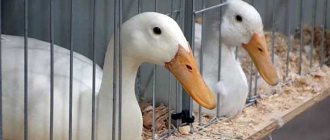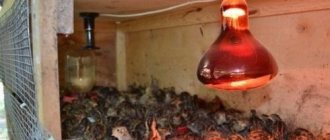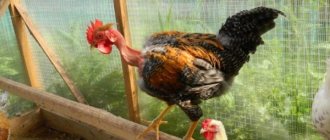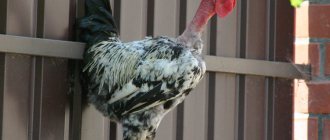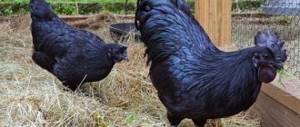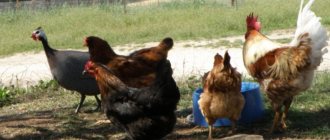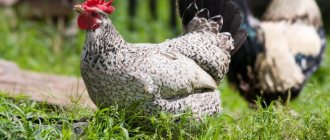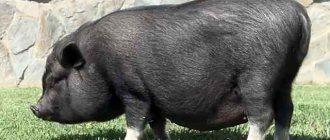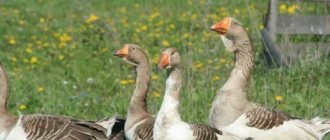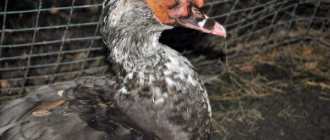Advantages of the breed
Indo-ducks are also called musk ducks. This is a separate subspecies created by nature itself. The first representatives were once domesticated in Mexico, but over time they began to be raised for meat in different countries of the world.
Features of indo-ducks:
- omnivorous;
- unpretentious in care;
- this is almost the only subspecies of ducks that does not require a pond nearby;
- amenable to incubation;
- lay up to hundreds of edible eggs per year;
- belong to quiet breeds, do not make noise like their relatives;
- not susceptible to diseases;
- the meat has a delicate soft taste;
- quickly reach marketable weight (in 3-4 months);
- caring for ducklings;
- calm and friendly.
Please note that you can grow at home either as a seasonal part-time job, for example, at the dacha during the warm season, or on an ongoing basis. Then the birds will have to create suitable conditions for summer and winter. In each case, the investment and level of income received will be different.
How to raise turkey ducks at home for meat naturally?
The cost of one individual is quite low. First, buy young Indian ducks, and soon they will delight you with their first offspring. You should buy them at the beginning or middle of the autumn season, when they become ducks and young drakes. For the appearance of ducklings in winter and spring, one drake is placed with 3-5 ducks. Female Muscovy ducks take excellent care of their offspring.
The bird should be kept separately from other animals in your yard - in a small built poultry house. The room should be kept cool on hot summer days, and warm in winter. The exit of windows and doors is to the south and to the side from which the winds constantly blow. The area of the poultry house is calculated from the number of birds housed per 1 sq.m. Usually 3 ducks and a maximum of 8 ducklings.
Adults lay eggs with the onset of April warmth. It is important to prevent eggs from lying in the nest for a long time. Once the clutch has reached 20 eggs, the female nests. First you need to prepare the nest. This can be a simple cardboard box, lined with any fabric (burlap) at the bottom. The use of synthetics is unacceptable.
A container of water for drinking and bathing should be placed in close proximity to the hatching site. While bathing, the duck destroys various parasites and moisturizes the nest. Hatching of eggs takes 1 month. There should be no other ducklings near the hen. The female is able to leave her clutch and go out for a walk with other people's ducklings.
Due to the preserved instinct for flight, in day-old chicks the tips of the wings are docked (cut off) to the first phalanx. The cut areas are treated with hydrogen peroxide or potassium permanganate. Adults do not need wing docking. They stop laying eggs before their wings are fully grown.
For business, it is better to buy raised ducklings born this year. From such ducks, offspring can be obtained as early as next spring. The cost of a grown bird is about 800 rubles per head, the cost of a chicken is from 100 rubles.
Economic maturity of females occurs at the age of 196-200 days; inducing egg laying earlier is not recommended. Mature individuals begin to lay eggs in February-March. In one season, a duck can hatch 2-3 broods of 20 eggs each. The first egg production cycle lasts five months and during this time ducks can lay 60-80 eggs, then rest (molt) for three months, then history repeats itself. Fertilization in drakes in the spring (April-May) is 100%, in the fall it decreases by half.
Within 2 months after hatching from eggs, indo-ducklings reach a weight of 2-2.4 kg. Further, their content is considered inappropriate. The deadline for slaughtering birds can be determined using the example of French farms: drake - after 70 days and duck - after 65 days. After 70 days, ducklings begin molting and losing weight. This results in the formation of stumps (the beginnings of new feathers) that are difficult to remove from the carcasses.
The average selling price of an Indian duck carcass is 270 -300 rubles per kilogram. The average carcass weight is 1.5 kilograms.
List of advantages of raising turkey ducks for meat at home
- Increased vitality and high survivability. With proper care, the survival rate at the time of sale is 95%-100%.
- It can be grown in a simple shed or other ventilated area. The main thing is that it should be warm and free of drafts.
- They do not require ponds. A small garden plot with a trough of water is suitable for maintenance.
- They treat strangers calmly without shouting (quacking).
- You can feed a variety of types of food and feed mixtures.
- The eggs are edible. It is impossible to eat them from under an ordinary duck. Each year, the Muscovy duck can lay approximately 100 eggs. Each weight is 70 g.
Where to begin?
In any case, you will have to carefully think through everything in advance, calculate it, and draw up a business plan. This is the only way to achieve stable profits and not take risks.
The steps for setting up a poultry farm are as follows:
- Initially, you need to study in detail all the information about Indian ducks, listen to advice in order to know how to feed them correctly, care for them, and what the bird needs.
- Build a room for winter maintenance if year-round production is planned.
- Purchasing suitable food.
- Purchase of breeding material.
- Breeding offspring.
- Direct cultivation.
- Slaughter and sale of carcasses.
If an entrepreneur decides that this is only a seasonal income, then there is no need to erect extra buildings, which will significantly save investments. But remember that in this case, every year you will have to spend money on buying ducklings and again look for customers for meat. With constant cultivation, capital investments are noticeable only at the start, but subsequently the efforts bring a stable profit.
Is breeding musk ducks at home profitable as a business?
According to one version, Indian ducks received their nickname from the Indian Musque tribe. The breed was brought to the Russian Empire under Queen Elizabeth. Since that time, this breed of poultry began to spread throughout the earth. Modern amateur poultry farmers are increasingly interested in how to keep turkey ducks at home. Some want to consistently receive additional profit, others strive to organize a full-fledged and profitable business. The main income of such activities is making a profit from the sale of bird carcasses. A duck that is more massive in weight and size will bring greater benefits. Among the hatched ducklings, half of the brood are males, which satisfy these indicators. To increase the size of the bird by 1.5-2 times, it is worth additionally feeding it with supplements containing various useful vitamin and mineral supplements.
Now, let's calculate the financial side of the business. We breed Indian ducks on our property; we have a barn with electricity. Costs for feeders, perches for ducks, purchase of hay, insulation of the barn - 10,000 rubles. To breed chicks, we buy grown ducks in October - 1 drake and 5 ducks for 3,000 rubles. Conventionally, we assume that vegetables such as potatoes and beets, necessary for feeding adult ducks, are available and are not included in the profit calculation.
Conventionally, we assume that each duck will bring us 80 eggs. The result was 400 chickens. The average weight of a carcass is 1.5 kilograms, the cost of selling a turkey carcass is 270 rubles per 1 kilogram, we slaughter it from 60 to 70 days. Revenue for the second year amounted to 162,000 rubles, costs (feed, electricity, veterinary drugs, etc.) for two years amounted to 129,842 rubles. Let us immediately make a reservation that the calculation of feed was carried out strictly according to the standards for both adult ducks and chicks. Taking into account the costs of purchasing chicks and preparatory work, the total cost was 142,842 rubles. The profit amounted to 19,158 rubles.
Of course, this calculation does not take into account the time spent on breeding poultry, nor does it take into account how you will look for clients to sell the carcasses. Our task was to show with this calculation that raising indo-ducks can be profitable. Therefore, if you decide to start this business, try everything first on a small batch, and then become a farmer and develop the business.
Conclusion. Raising turkey ducks at home is profitable. After all, the price of meat is much higher than the cost of carcasses of ordinary domestic ducks. Meat is much tastier, it is dietary, contains a minimum of fat, and eggs have good taste. If desired, you can also organize the sale of eggs, especially since this market niche has practically not yet been developed. In any case, you are guaranteed a regular wholesale buyer.
Breeding methods
Since Indian ducks are bred primarily for meat, the process of reproduction and maintenance is considered the most important. For this purpose, breeding individuals are purchased, from which new ducklings are obtained on an ongoing basis. And having grown them to market size, they sell fresh carcasses.
But it is worth noting that today two breeding methods are popular:
- Nesting - why a simple room is being set up. It is enough to put a cardboard box in it and line the bottom with natural fabric. The duck hatches the eggs on its own. Be sure to arrange everything so that the hen can eat, drink and wash herself without moving far from the masonry. After 30-35 days you can expect offspring.
- Incubator - when purchasing eggs or receiving them from breeding individuals, they are placed in a special apparatus. The required temperature is constantly maintained in it, and ventilation of the container is also important. Up to 50 pieces are usually placed in one tray, which are 5-6 days old from the moment of appearance. The ripening period is approximately the same as in natural conditions.
Each method has its own advantages and disadvantages, which you should always keep in mind. So, in the first case, it is important to provide optimal conditions for the duck that is hatching eggs and not to show her ducklings from other broods, otherwise she, driven by maternal instinct, may go after them and forget about the clutch she left behind.
The second breeding option is considered more expensive, but this is only at first, since later you will no longer have to purchase an incubator. In this case, optimal parameters are achieved, which are much easier to control. In order to save money and if you have certain skills, you can make such a device yourself.
Options to save
Purchasing an incubator in which young animals are bred does not always pay off. The price of the device is about 45 thousand. It is worth considering the fact that when purchasing eggs, the time for raising young animals will increase by a month.
At the same time, the cost of electricity and other utility bills will have to be subtracted from income. It is also mandatory to pay a tax of 6%. Remember also that not all eggs will produce full-fledged and physically healthy chicks. The percentage of death during incubation ranges from 20% to 30%.
The total amount of incubation costs reduces profits by at least 25%. And when purchasing 500 chicks, the cost of purchasing them will be from 3 to 5 thousand rubles.
When developing a duck breeding business plan, carefully select the breed. Meat varieties are considered the most profitable in terms of profitability. They are ready for slaughter already in the third month of life. The number of birds is directly proportional to the growth of profits. The reason is to reduce the risks associated with mortality and slow weight gain of individual individuals. Therefore, the purchase of as many ducks as possible takes place.
Read more: Pushkin breed of chickens: history of the breed, breeding
Room
If you are going to breed Indian ducks all year round and make a profit every 3-4 months, then you should carefully prepare a place for them to live. A small shed measuring 75-100 square meters will do for this. m. for keeping 500 birds. It is important to maintain these proportions - for 8-10 individuals you need 1.5 square meters. m. of free space.
And although it is believed that they do not need a pond nearby, still make sure that there is constant availability of water in the area so that they can wash themselves, cool off on a hot day, or just have a drink. But the room itself where the ducks live must be dry. Remember also about the correct ratio of breeding individuals - there is one drake for every 4-6 females.
Ideally, for a poultry farm, it is advisable to build several rooms at once or divide one into sections. So, the first is needed for adult individuals purchased or raised to produce offspring. The second is for those hens who hatch eggs if the plan does not include an incubator. The third part is for young animals, which are fattened for 3-4 months until they reach marketable weight.
Remember that eggs can be sold if you find sales channels for such a product. But most of them will be spent on producing offspring. It is best to periodically select the strongest and largest of the ducklings to update breeding individuals, and all the rest are fattened and sold. Some farms specialize in using indo-ducks to breed a special breed - mulards, because they do not reproduce on their own.
Business setup
- The poultry house must be equipped with nests and clean bedding. The Indian duck needs access to water, so care should be taken to ensure a constant supply of clean liquid. To do this, they organize different types of drinking bowls, often homemade.
- Ventilation and thermal conditions are required. There should be no drafts. Experienced poultry farmers recommend installing ventilation with warm air. In warm weather, ducks are free to range, which reduces the amount of work in the poultry house.
- Pay special attention to nests if you intend to independently raise young animals. The Muscovy duck is a caring hen who is sensitive to her eggs and may not budge until the chicks hatch. You can organize an incubator (additional investment). This approach to poultry farming will provide greater profits than buying chicks from other farmers. Nests are also needed for laying eggs that will be sold to buyers. The number of eggs can reach 50-60 eggs per year from one female.
- Feeders should be located in a convenient place for both the birds and the owner. The food must be fresh, so feeders need to be disinfected to prevent diseases in pets. At the same time, the wards should not throw food around so that there is no dampness in the room and the bedding does not have to be changed frequently.
- The area of the outdoor enclosure for Indian ducks depends on their number. The area should be fenced to prevent other animals from getting to the ducks.
Additionally, you need a place to store feed and a workshop for slaughtering poultry.
In order for a farm for breeding and raising indo-ducks at home to generate income, the poultry farmer needs to solve several issues. The first is to become familiar with the peculiarities of their maintenance and breeding, as discussed above. Now it’s time to solve two more: reducing costs and increasing the profits of the future business.
Reduce costs
So, how can a poultry farmer reduce the cost of setting up and maintaining his farm? The answer lies in two simple things: knowledge and skills. The more a person knows and can do on his own, the less his expenses will be. Several examples confirm this point.
You can start with a poultry house. You can turn to construction companies or handy neighbors. In this case, you will have to pay not only for materials, but also make a considerable premium for the work. Often this amount approaches or even exceeds that spent on consumables. If the poultry farmer masters this craft on his own, expenses at this point will be reduced by at least half.
Now regarding drinking bowls and feeders. The same story. You can buy ready-made ones, but they will cost twice or three times more than the materials used. If you assemble them yourself, turning to training photos and videos in the first couple of steps, then you can avoid unnecessary expenses.
Finally, there is a fairly simple way to save on treating ducks. To do this, you just need to keep them healthy. Which, in turn, requires three things: proper feeding and watering, regular cleaning of the cages and periodic inspections of the birds for abnormalities. In the latter case, it would be a good idea to consult a veterinarian, but most of the main symptoms can be noticed at an early stage, even on your own.
Increased profits
Now let's talk about how to increase the level of income from your farm. The first recommendation seems obvious, but in modern realities it is not applied by everyone and not always: first you need to protect yourself from the legislative side by filling out all the necessary papers. Surprisingly, not everyone fulfills this point, and then rushes around, paying fines and solving problems at the last moment, instead of calmly working on the farm.
The second is careful selection and care of the tribe. It is the breeding animals that are literally the future of the farm, so special attention must be paid to their maintenance. If you do not skimp here on the arrangement of the premises and a high-quality diet, then the birds will “repay” with healthy, strong and numerous young animals. By the way, incubators are often used on an industrial scale to breed the latter.
And finally, the third thing is hiring qualified and diligent workers. In a fairly large farm, it is impossible to cope alone. Help with raising birds will be required, otherwise difficulties will begin to grow like a snowball. Even ordinary cleaning of cages can take a lot of effort and time, dulling the attention of an exhausted poultry farmer, and in this case it is easy to miss the emergence of a real problem on the farm, such as an infectious disease.
To create a duck breeding business you will need the following equipment:
- freezer for storing main products: eggs and meat;
- incubators: standard capacity - 60 eggs, average cost - about 5-6 thousand rubles per unit;
- a special machine for plucking ducks: the device will help save as much time as possible in this process, the cost of such a machine is about 6,000 rubles;
- feeders and drinkers.
You can reduce the amount of investment by making your own feeders.
The room for keeping poultry must be well insulated, since ducks do not tolerate sudden changes in temperature. It will be necessary to build ventilation to supply warm air during frosts. To keep the livestock warmer in winter, half of the poultry house can be covered with grass.
Read more: Strasensky grape variety description
The floor should be 25-30 cm higher than the ground level: this will prevent rodents from entering the duck breeding area.
In winter, it is necessary to provide birds with artificial light in the morning and evening, due to the short length of the day. The room must also be ventilated periodically.
As for the enclosure for walking, there is a certain rule, which stipulates that there should be a space of 1 square meter for two individuals. m. That is, for a livestock of 200 individuals you will need an enclosure of at least 100 square meters. m. The walking area must be surrounded by a fence.
Increased profits
Diet
It is believed that in terms of feeding and care, Indian ducks are unpretentious. They are omnivorous and picky. However, in order to achieve the best taste characteristics of meat, you should select the right food. So, you can give them:
- Cereals – oats, barley, wheat.
- Vegetables – carrots, potatoes, rutabaga, turnips.
- Mash.
- Tops, grass.
- Coarse flour.
- Compound feed.
It is periodically necessary to moisten food, for example, by pouring kefir on it. It is also very important to saturate the bird’s body with useful microelements. To do this, add egg shells, special fertilizers, pebbles, etc. to the diet. In order to save money, you can also grow certain types of vegetables or grains.
Features of poultry farming
Despite the use of two roots “ind” and “duck” in the name of the individual, the bird has no relation to turkeys. This is a separate species that is classified as a musk breed. The Indian duck differs from the ordinary duck in some respects:
- Appearance.
- Quality and taste of meat (more tender than regular duck).
- The benefits and taste of eggs (used in the human diet along with chicken eggs). In an ordinary duck, eggs are used only for breeding.
The Indian duck is easy to care for and does not need a pond, although it is a waterfowl. Many farms and poultry farms give preference to indo-ducks for breeding. But is this direction profitable in the field of rural business? It all depends on the capabilities of the breeder, his knowledge of the rules of poultry care, and the availability of a customer base for selling products.
Slaughter and sales
Already at the age of 2-3 months, Indian ducks are suitable for sale, as they reach marketable weight. If you wish, you can let them grow a little more to get maximum profit. It is very important to find customers in advance who will purchase the product on an ongoing basis, otherwise the sales process will become too complicated.
And although turkey meat is not yet popular among the population, due to its high taste characteristics it is still in definite demand. Sales channels should be established through specialized stores, markets, restaurants, and sanatoriums. You can open your own point of sale or sell meat via the Internet.
It is important to arrange a slaughter area separate from the poultry house. It contains all the necessary equipment, tables, refrigerators and freezers. The resulting carcasses are stored in cooling units so that the product does not spoil.
You can download a free sample duck farm business plan here.
Necessary equipment
Drinkers and feeders. They are bought in specialized stores or built independently. How exactly is described in the articles “How to make a duck feeder with your own hands” and “How to make a water bowl for ducklings with your own hands.”
If you are breeding and raising young animals, you will need an incubator.
Lamps with red lighting, which are installed inside the poultry house.
Stove and ventilation equipment.
To process carcasses, plucking equipment and refrigerators for storing carcasses are useful.
If the number of birds is 80-100 individuals, purchasing equipment will cost the breeder 100 thousand rubles.
Profitability
The cost of keeping one bird is very low. Although the level of investment is influenced by many factors. So, it depends on the breeding method, the availability of skills to build a barn, create an incubator, feeders, etc. The choice of food also affects the money spent. But thanks to the rapid weight gain, high egg production and good survival rate of ducklings, the business turns out to be profitable in any case.
| Expenses | Cost, in rubles | |
| 1 | Purchase of chicks (500 pieces) | 30 000 |
| 2 | Food for 2 months | 30 000 |
| 3 | Public utilities | 10 000 |
| Total: | 70 000 |
During this period, the acquired chicks will grow into adults weighing 2.5 kg. Having sold them even at a wholesale price of 600 rubles, the income will be no less than 300,000. That is, the net profit for 2 summer months will reach 130 thousand. If you take up business more seriously and purchase only breeding specimens, equip them with premises and an incubator yourself, then every 3-4 months you can receive a steadily growing profit.
Video: the intricacies of breeding Muscovy ducks.
Choice of legal form
Opening a business is possible in several formats that require different investments:
- LPH. Indo-ducks are raised for personal use, and the surplus can be sold on the market. You won't get much income, but some of the costs will be reimbursed. Indo-ducks are kept in a common yard with other animals and do not require special conditions. In this case, the business does not need to be registered if the income from it is not permanent.
- Small business. Allows you to receive more income. All birds can be sold for profit. It is necessary to build a separate poultry house and constantly monitor the renewal of offspring so as not to interrupt the chain. It is registered as a peasant farm (if the cultivation is carried out by a family contract) or as an individual entrepreneur (if the farmer uses hired labor).
- A large poultry farm that sells products in large wholesale. Turkey can be one of the types of poultry raised on the farm, because the main demand among grocery chains is for chicken and turkey. It is registered as an LLC, aimed at wholesalers and large chains.
If you need a small increase in your existing income, then it is possible to breed muscovy ducks in your personal backyard in the amount of 30-50 heads. The bird adapts well to the conditions and coexists with other animals without problems. No paperwork is required, but carcasses must be sold independently and to a limited extent. This will bring a profit of 20-40 thousand rubles per season.
Our business idea is focused on a small subsidiary farm, which can provide the owner with a certain income.
Indo-ducks, also known as “muscovy ducks”, themselves have a lot of advantages that greatly facilitate their stable and rapid breeding. If we talk briefly about the main advantages, then it is worth noting the following:
- high rates of vitality and immunity;
- unpretentiousness in terms of nutrition;
- a well-preserved instinct to care for your ducklings;
- calm and friendly character;
- quiet hissing instead of loud quacking;
- lean and healthy meat;
- high egg production.
All these points lead to the fact that raising and breeding indo-ducks is not particularly difficult; even a novice poultry farmer can cope with this. Of course, a certain set of knowledge and training is needed here too.
Reviews
Oleg: “It is not as easy to work with any living beings as it seems at first glance. You need to constantly be present, monitor the farm, clean the poultry house, collect eggs, etc. But with established sales channels, all efforts pay off.”
Marina: “This is very profitable, but only if you have a plot outside the city or even a house. By setting up a barn with your own hands and making an incubator from scrap materials, basic costs are significantly saved. But if you buy or rent everything, then the business ceases to be so attractive from a financial point of view.”
Peter: “It seems to me that our people are not yet very accustomed to seeing turkey meat on the shelves, and usually only chicken and turkey are purchased from birds. And selling eggs is not at all possible. So it’s better to find buyers first, and then start organizing the business.”
Investments, profitability and payback
Any start of your own business requires a competent approach and careful study of a particular industry. Breeding ducks for sale is no exception. Before you take action, you will need to draw up a detailed business plan. It will not only speed up the creation and development of a business, but will also allow you to avoid most of the mistakes that novice entrepreneurs often make.
To become better acquainted with such a business and learn all the intricacies of running it, it is recommended to start with a small number of ducks.
To open a small farm (100 individuals) for breeding ducks, you will need the following investments:
- to equip a poultry house you will need approximately 40,000-50,000 rubles (building a building from scratch will cost 300,000-350,000 rubles);
- purchasing the necessary equipment and inventory (incubators for hatching chicks, feeders, drinking bowls) will cost approximately 50,000-60,000 rubles;
- purchasing a livestock of ducklings will cost 9,000-11,000 rubles (the average cost of one duck is 100 rubles);
- purchase of feed – 10,000-20,000 rubles;
- unplanned expenses - 20,000-30,000 rubles.
According to calculations, opening a small poultry farm for breeding ducks will cost approximately 120,000-170,000 rubles, but only if you have your own premises for arranging a poultry house. The payback period for such a facility will be approximately a year.
For higher profits, you should actively work on expanding the farm so that over time the number of ducks is at least 1000. Then the income will be solid.
As an example, let's take the case when an entrepreneur opens a duck farm for 100 ducks. This activity will entail costs for:
- building an enclosure from scratch: will cost up to 350 thousand rubles;
- arrangement of already built: up to 50 thousand rubles;
- purchase of equipment: up to 120 thousand rubles;
- purchase of ducklings: up to 11 thousand rubles;
- purchase of feed: up to 12 thousand rubles;
- unplanned expenses: up to 30 thousand rubles.
Read more: What to feed turkey ducks at home for egg production
To sum it up, the costs, taking into account an unequipped poultry house, will be about 220 thousand rubles.
The period during which your business will pay off in case of rapid success varies from 7-8 months to one year.
